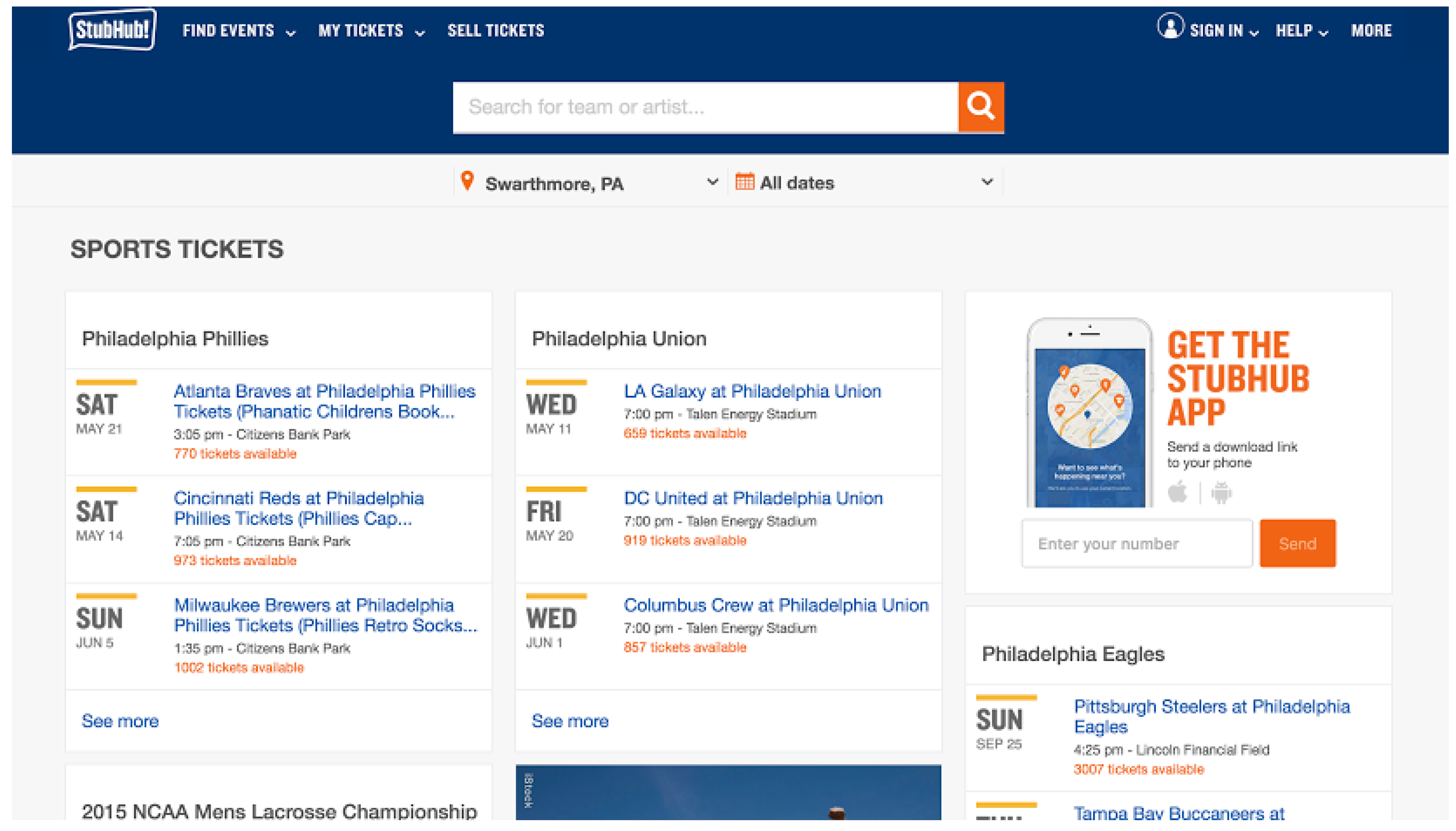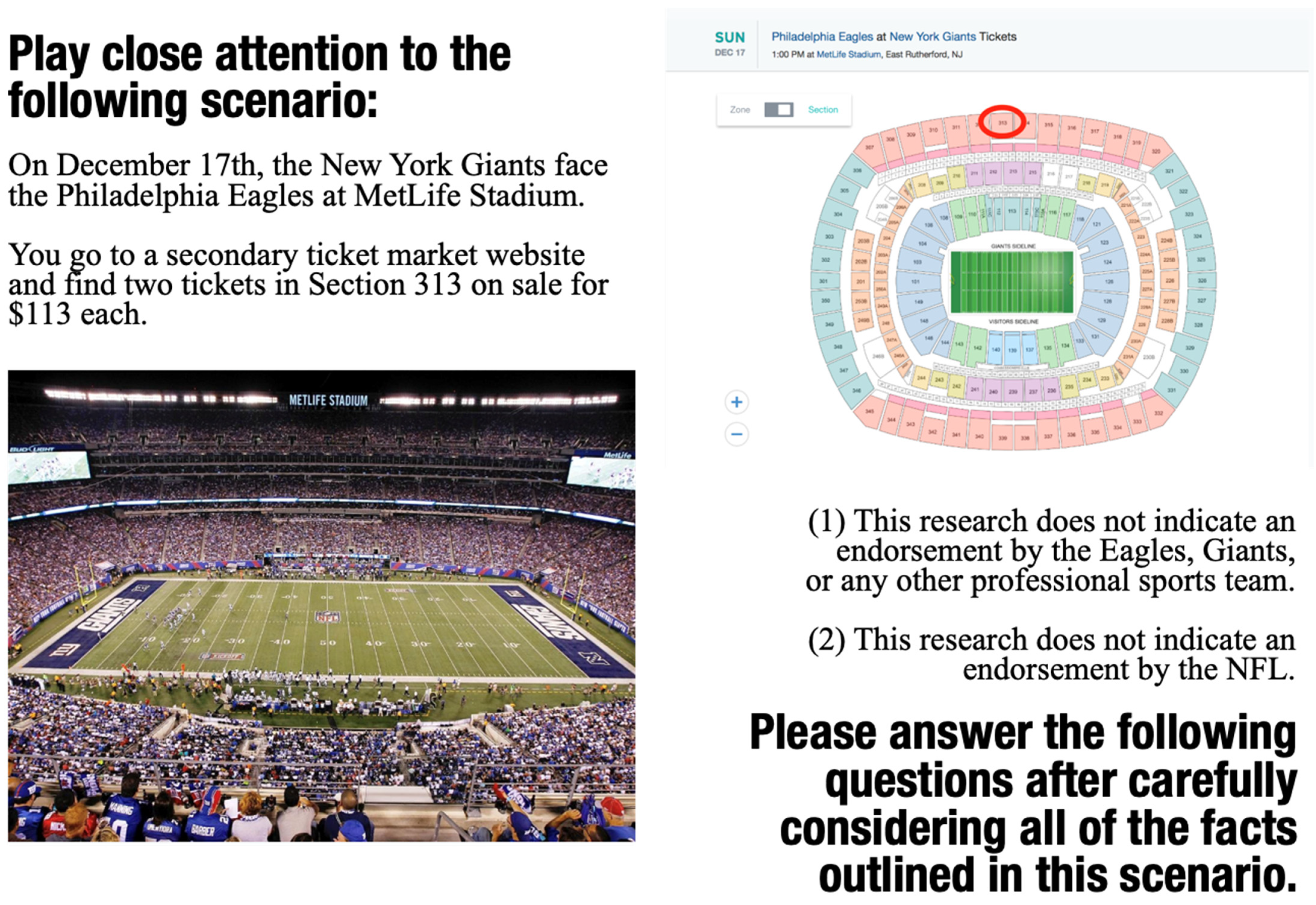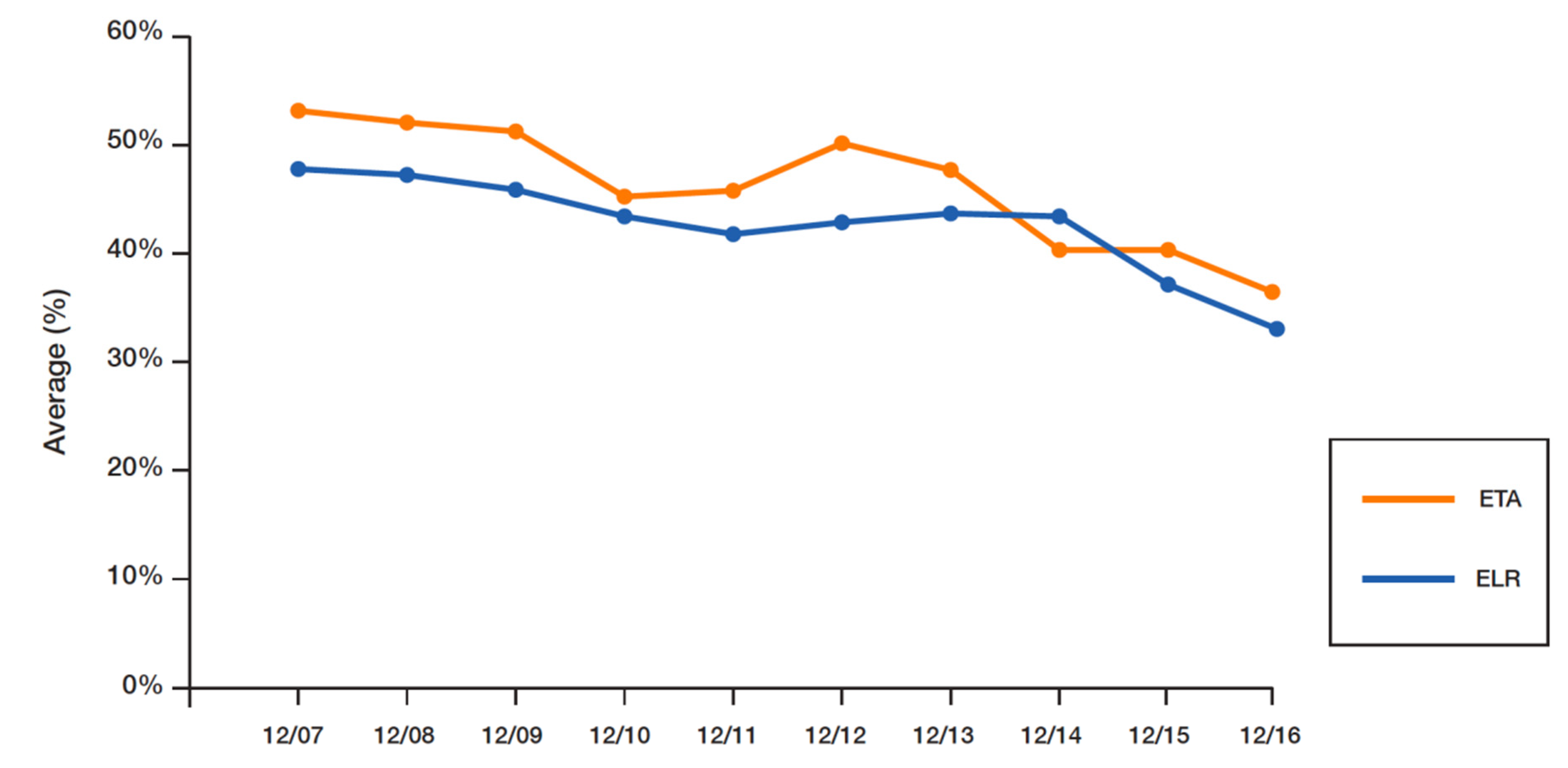“10,000 Available” or “10% Remaining”: The Impact of Scarcity Framing on Ticket Availability Perceptions in the Secondary Ticket Market
Abstract
1. Introduction
2. Theoretical Background
2.1. Generic Advanced Decision-Making Model and Sport Ticket Booking Behavior
2.2. Framing Effect
2.3. Scarcity Framing and Numeracy
3. Methods and Measurements
3.1. Sample and Procedures
3.2. Manipulation Check
3.3. Dependent Variable
3.4. Independent Variable
3.5. Statistical Analysis
4. Results
5. Discussion
5.1. Theoretical Implications
5.2. Practical Implications
5.3. Limitations and Future Research
Author Contributions
Funding
Institutional Review Board Statement
Informed Consent Statement
Data Availability Statement
Conflicts of Interest
References
- The Secondary Ticketing Market Is Worth $15 Billion. How Long Will Fans Have to Pay? Big Think, 26 March 2019.
- A Shock to the Secondary Ticket Market. Available online: https://www.sportsbusinessjournal.com/Journal/Issues/2020/03/23/In-Depth/Secondary.aspx (accessed on 5 April 2023).
- U.S. Government Accountability Office. Event Ticket Sales: Market Characteristics and Consumer Protection Issues|U.S. GAO. Available online: https://www.gao.gov/products/gao-18-347 (accessed on 5 April 2023).
- Cosgrove, E. EBay to Sell StubHub to Viagogo for about $4 Billion in Cash. Available online: https://www.cnbc.com/2019/11/25/ebay-nears-deal-to-sell-stubhub-to-viagogo-for-about-4-billion-dj-citing-sources.html (accessed on 5 April 2023).
- Drayer, J.; Martin, N.T. Establishing Legitimacy in the Secondary Ticket Market: A Case Study of an NFL Market. Sport Manag. Rev. 2010, 13, 39–49. [Google Scholar] [CrossRef]
- Drayer, J. Making a Case for the Integration of the Primary and Secondary Ticket Markets for Professional Team Sports in the United States. Int. J. Sports Mark. Spons. 2011, 12, 2–11. [Google Scholar] [CrossRef]
- Drayer, J.; Rascher, D.A.; McEvoy, C.D. An Examination of Underlying Consumer Demand and Sport Pricing Using Secondary Market Data. Sport Manag. Rev. 2012, 15, 448–460. [Google Scholar] [CrossRef]
- An Analysis of Attributes Impacting Consumer Online Sport Ticket Purchases in a Dual-Market Environment—ProQuest. Available online: https://www.proquest.com/openview/360540f8676a801215ec4647c5df9ca7/1?pq-origsite=gscholar&cbl=28711 (accessed on 5 April 2023).
- Won, M.; Shapiro, S.L. Analysis of Price Bundling and Framing: The Impact of Availability and Discount Messaging. Sport Bus. Manag. Int. J. 2021, 11, 493–514. [Google Scholar] [CrossRef]
- Aggarwal, P.; Jun, S.Y.; Huh, J.H. Scarcity Messages. J. Advert. 2011, 40, 19–30. [Google Scholar] [CrossRef]
- Hodkinson, C. ‘Fear of Missing Out’ (FOMO) Marketing Appeals: A Conceptual Model. J. Mark. Commun. 2019, 25, 65–88. [Google Scholar] [CrossRef]
- Levin, I.P.; Schneider, S.L.; Gaeth, G.J. All Frames Are Not Created Equal: A Typology and Critical Analysis of Framing Effects. Organ. Behav. Hum. Decis. Process. 1998, 76, 149–188. [Google Scholar] [CrossRef]
- Levin, I.P. Associative Effects of Information Framing. Bull. Psychon. Soc. 1987, 25, 85–86. [Google Scholar] [CrossRef]
- Peng, J.; Li, H.; Miao, D.; Feng, X.; Xiao, W. Five Different Types of Framing Effects in Medical Situation: A Preliminary Exploration. Iran. Red Crescent Med. J. 2013, 15, 161–165. [Google Scholar] [CrossRef]
- Dwyer, B.; Drayer, J.; Shapiro, S.L. Proceed to Checkout? The Impact of Time in Advanced Ticket Purchase Decisions. Sport Mark. Q. 2013, 22, 166–180. [Google Scholar]
- Slovic, P. Understanding Perceived Risk: 1978–2015. Environ. Sci. Policy Sustain. Dev. 2016, 58, 25–29. [Google Scholar] [CrossRef]
- Brewer, N.T.; Weinstein, N.D.; Cuite, C.L.; Herrington, J.E. Risk Perceptions and Their Relation to Risk Behavior. Ann. Behav. Med. 2004, 27, 125–130. [Google Scholar] [CrossRef] [PubMed]
- Johnson-Laird, P.N. Mental Models: Towards a Cognitive Science of Language, Inference, and Consciousness; Harvard University Press: Cambridge, MA, USA, 1983; ISBN 978-0-674-56882-2. [Google Scholar]
- Frisch, D. Reasons for Framing Effects. Organ. Behav. Hum. Decis. Process. 1993, 54, 399–429. [Google Scholar] [CrossRef]
- Thaler, R.H.; Johnson, E.J. Gambling with the House Money and Trying to Break Even: The Effects of Prior Outcomes on Risky Choice. Manag. Sci. 1990, 36, 643–660. [Google Scholar] [CrossRef]
- Kahneman, D.; Tversky, A. Prospect Theory: An Analysis of Decision under Risk. Econometrica 1979, 47, 263–291. [Google Scholar] [CrossRef]
- Tversky, A.; Kahneman, D. The Framing of Decisions and the Psychology of Choice. Science 1981, 211, 453–458. [Google Scholar] [CrossRef] [PubMed]
- Kuo, F.-Y.; Hsu, C.-W.; Day, R.-F. An Exploratory Study of Cognitive Effort Involved in Decision under Framing—An Application of the Eye-Tracking Technology. Decis. Support Syst. 2009, 48, 81–91. [Google Scholar] [CrossRef]
- Parker, A.M.; Fischhoff, B. Decision-Making Competence: External Validation through an Individual-Differences Approach. J. Behav. Decis. Mak. 2005, 18, 1–27. [Google Scholar] [CrossRef]
- Pochon, J.-B.; Riis, J.; Sanfey, A.G.; Nystrom, L.E.; Cohen, J.D. Functional Imaging of Decision Conflict. J. Neurosci. 2008, 28, 3468–3473. [Google Scholar] [CrossRef]
- Armstrong, K.; Schwartz, J.S.; Fitzgerald, G.; Putt, M.; Ubel, P.A. Effect of Framing as Gain versus Loss on Understanding and Hypothetical Treatment Choices: Survival and Mortality Curves. Med. Decis. Making 2002, 22, 76–83. [Google Scholar] [CrossRef]
- Gamliel, E.; Peer, E. Attribute Framing Affects the Perceived Fairness of Health Care Allocation Principles. Judgm. Decis. Mak. 2010, 5, 11–20. [Google Scholar] [CrossRef]
- Kühberger, A. The Influence of Framing on Risky Decisions: A Meta-Analysis. Organ. Behav. Hum. Decis. Process. 1998, 75, 23–55. [Google Scholar] [CrossRef] [PubMed]
- Kamoen, N.; Mos, M.B.J. A Good Tennis Player Does Not Lose Matches. The Effects of Valence Congruency in Processing Stance-Argument Pairs. PLoS ONE 2019, 14, e0224481. [Google Scholar] [CrossRef] [PubMed]
- Cialdini, R.B. Influence (Rev): The Psychology of Persuasion; Harper Collins: New York, NY, USA, 1993; ISBN 978-0-688-12816-6. [Google Scholar]
- Lipkus, I.M.; Samsa, G.; Rimer, B.K. General Performance on a Numeracy Scale among Highly Educated Samples. Med. Decis. Making 2001, 21, 37–44. [Google Scholar] [CrossRef] [PubMed]
- Cokely, E.T.; Galesic, M.; Schulz, E.; Ghazal, S.; Garcia-Retamero, R. Measuring Risk Literacy: The Berlin Numeracy Test. Judgm. Decis. Mak. 2012, 7, 25–47. [Google Scholar] [CrossRef]
- Peters, E.; Västfjäll, D.; Slovic, P.; Mertz, C.K.; Mazzocco, K.; Dickert, S. Numeracy and Decision Making. Psychol. Sci. 2006, 17, 407–413. [Google Scholar] [CrossRef]
- Schwartz, L.M.; Woloshin, S.; Black, W.C.; Welch, H.G. The Role of Numeracy in Understanding the Benefit of Screening Mammography. Ann. Intern. Med. 1997, 127, 966–972. [Google Scholar] [CrossRef]
- Peters, E.; Hart, P.S.; Fraenkel, L. Informing Patients: The Influence of Numeracy, Framing, and Format of Side Effect Information on Risk Perceptions. Med. Decis. Making 2011, 31, 432–436. [Google Scholar] [CrossRef]
- Aguinis, H.; Villamor, I.; Ramani, R.S. MTurk Research: Review and Recommendations. J. Manag. 2021, 47, 823–837. [Google Scholar] [CrossRef]
- Using Multivariate Statistics. Available online: https://www.pearson.com/en-us/subject-catalog/p/using-multivariate-statistics/P200000003097/9780137526543 (accessed on 5 April 2023).
- Millennials Put Ticket Strategies to Test. Available online: https://www.sportsbusinessjournal.com/Journal/Issues/2015/06/08/In-Depth/Ticketing-main.aspx (accessed on 5 April 2023).
- Jacowitz, K.E.; Kahneman, D. Measures of Anchoring in Estimation Tasks. Pers. Soc. Psychol. Bull. 1995, 21, 1161–1166. [Google Scholar] [CrossRef]
- Putler, D.S. Incorporating Reference Price Effects into a Theory of Consumer Choice. Mark. Sci. 1992, 11, 287–309. [Google Scholar] [CrossRef]
- Pettibone, J.C. Testing the Effect of Time Pressure on Asymmetric Dominance and Compromise Decoys in Choice. Judgm. Decis. Mak. 2012, 7, 513–521. [Google Scholar] [CrossRef]
- Gierl, H.; Plantsch, M.; Schweidler, J. Scarcity Effects on Sales Volume in Retail. Int. Rev. Retail Distrib. Consum. Res. 2008, 18, 45–61. [Google Scholar] [CrossRef]




| Age | 33.674, Mean | Ethnicity | 76.3%, Caucasian |
| 11.792, St. Dev | 12.3%, Hispanic | ||
| Gender | 69.1%, Male | 6.1%, Asian | |
| 30.9%, Female | 5.3%, Other | ||
| 12.5%, Less than USD 20 K | 21.5%, High school | ||
| Household Income | 20.7%, USD 20 K–USD 40 K | Education | 4.1%, Bachelor’s degree |
| 22.9%, USD 40 K–USD 60 K | 18.0%, Graduate degree | ||
| 24.7%, USD 60 K–USD 80 K | 16.5%, Professional degree | ||
| 15.0%, USD 100 K–USD 200 K | 7.7%, Other | ||
| 3.4%, More than USD 200 K | 9.0%, Did not specify |
| Expected Ticket Availability | Expected Lower Rate | ||||
|---|---|---|---|---|---|
| Days Before the Game | Number of Observations | Average (%) | SD | Average (%) | SD |
| 10 | 40 | 53.72 | 28.88 | 48.92 | 29.19 |
| 9 | 80 | 52.13 | 24.09 | 48.13 | 23.57 |
| 8 | 54 | 50.33 | 25.85 | 46.22 | 28.49 |
| 7 | 48 | 46.22 | 28.47 | 44.93 | 28.83 |
| 6 | 71 | 47.36 | 28.95 | 42.53 | 24.32 |
| 5 | 80 | 50.08 | 29.97 | 43.98 | 27.65 |
| 4 | 56 | 48.73 | 29.81 | 44.94 | 28.42 |
| 3 | 60 | 40.33 | 22.68 | 44.31 | 24.18 |
| 2 | 76 | 40.81 | 27.98 | 38.63 | 29.21 |
| 1 | 76 | 37.89 | 28.15 | 35.88 | 29.75 |
| Expected Ticket Availability | Expected Lower Rate | ||||
|---|---|---|---|---|---|
| Scarcity Framing | Number of Observations | Average (%) a | SD | Average (%) b | SD |
| Raw Numbers | 208 | 52.13 | 26.46 | 50.38 | 27.23 |
| Percentages | 213 | 40.63 | 27.57 | 38.33 | 25.87 |
| Expected Ticket Availability | Expected Lower Rate | ||||
| Game Demand | Number of Observations | Average (%) c | SD | Average (%) d | SD |
| Low | 203 | 49.50 | 30.32 | 46.52 | 29.24 |
| High | 218 | 43.35 | 25.58 | 42.21 | 25.50 |
Disclaimer/Publisher’s Note: The statements, opinions and data contained in all publications are solely those of the individual author(s) and contributor(s) and not of MDPI and/or the editor(s). MDPI and/or the editor(s) disclaim responsibility for any injury to people or property resulting from any ideas, methods, instructions or products referred to in the content. |
© 2023 by the authors. Licensee MDPI, Basel, Switzerland. This article is an open access article distributed under the terms and conditions of the Creative Commons Attribution (CC BY) license (https://creativecommons.org/licenses/by/4.0/).
Share and Cite
Jee, W.; Hyun, M. “10,000 Available” or “10% Remaining”: The Impact of Scarcity Framing on Ticket Availability Perceptions in the Secondary Ticket Market. Behav. Sci. 2023, 13, 338. https://doi.org/10.3390/bs13040338
Jee W, Hyun M. “10,000 Available” or “10% Remaining”: The Impact of Scarcity Framing on Ticket Availability Perceptions in the Secondary Ticket Market. Behavioral Sciences. 2023; 13(4):338. https://doi.org/10.3390/bs13040338
Chicago/Turabian StyleJee, Wonsok (Frank), and Moonsup Hyun. 2023. "“10,000 Available” or “10% Remaining”: The Impact of Scarcity Framing on Ticket Availability Perceptions in the Secondary Ticket Market" Behavioral Sciences 13, no. 4: 338. https://doi.org/10.3390/bs13040338
APA StyleJee, W., & Hyun, M. (2023). “10,000 Available” or “10% Remaining”: The Impact of Scarcity Framing on Ticket Availability Perceptions in the Secondary Ticket Market. Behavioral Sciences, 13(4), 338. https://doi.org/10.3390/bs13040338






